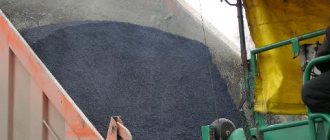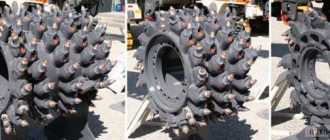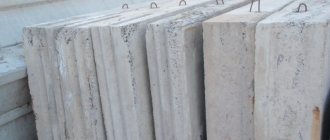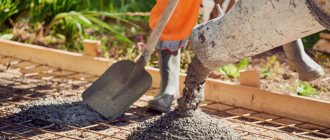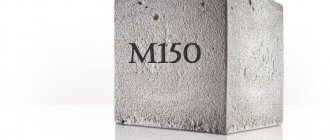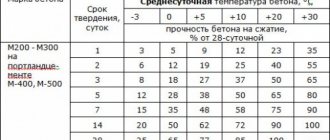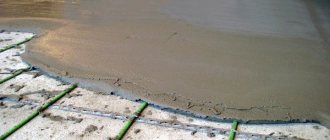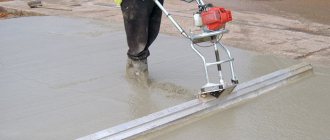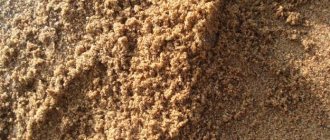Since its discovery, concrete has become one of the most important building materials. This is due to its high performance properties. But it also has several disadvantages. The most significant of them is low resistance to sub-zero temperatures. Currently, this problem no longer exists. A variety of additives to concrete to increase frost resistance help improve the material's resistance to winter conditions.
Why are additives needed in concrete?
What are concrete additives? These are chemicals that can be of either organic or non-organic origin. They are found in solid and liquid states, as well as in the form of pastes of varying degrees of consistency. In total, more than three hundred different types of additives are used in construction. Such a wide variety is due to various modifying effects. Therefore, to choose the right supplement, you need a clear idea of the goal that needs to be achieved.
Coloring additives for concrete
Concrete has a strong alkaline reaction, so conventional dyes are not suitable for concrete; they quickly discolor in an alkaline environment. Concrete pigments are based on alkali-resistant chromium and iron oxides that are resistant to UV rays.
When preparing concrete yourself, any additives should be used after carefully reading the technical specifications, and avoid overdosing (this does not apply to microsilica and fiber fiber, and the cost of these materials is quite high). Additives should be used in accordance with the recipe. Most supplements are complex, and it is not always possible to combine different types of supplements. Some of the most recognizable and trusted brands: Alliance, Fortrais, Poliplast (brands Cryoplast, Relamix, Aeroplast), Superplast.
The influence of additives on the properties of concrete
1. Antifreeze additives in concrete.
An integral component for preparing the solution is water. What happens to water at sub-zero temperatures? That's right, it turns into ice, which is a very serious problem during construction. The process of hydration (the combination of cement and water) loses its dynamics already at temperatures below fifteen degrees Celsius, to say nothing of the situation with a negative value on the thermometer. Maintaining positive temperatures is possible by laying a heating wire or constructing auxiliary formwork. These measures help, but increase construction time and financial costs. The main principle of operation of antifreeze additives is to maintain the plasticity of concrete at sub-zero temperatures by preventing the freezing of the liquid that is in the mixture and, thanks to this, allowing the mixture to harden and gain strength.
2. Plasticizers.
The workability of concrete is a very significant factor in construction, especially if you have to deal with thin-walled structures or formwork of complex geometry. Also, during installation, it is necessary to avoid the formation of voids and cavities, which have an extremely negative effect on the strength and reliability of concrete structures. Plasticizers allow you to achieve the necessary dilution of the solution while maintaining the required proportions of the components (water, sand, etc.). The principle of operation is based on increasing the water-retaining characteristics of the solution. In addition, it is worth noting the increase in the strength of concrete using plasticizers (up to 25%).
3. Additives to maintain the mobility of the concrete mixture
are used when long-term transportation of the solution is necessary. Their use also finds its place in the warm season, since at high temperatures the process of hardening of the concrete mixture proceeds faster. These additives increase the duration of the process of forming the structure of cement stone by making it difficult for water molecules to access cement particles, that is, slowing down hydration.
4. Modifying additives
are used to improve various characteristics of a concrete mixture. It often happens that when constructing certain structures, it is necessary to achieve a specific density from the solution. For example, for the construction of a swimming pool, concrete with increased moisture permeability is used, and for load-bearing structures of buildings, concrete with a higher strength class should be used. Air-entraining, gas-forming and water-repellent additives will help achieve the required porosity of concrete, depending on the task.
5. Additives to accelerate strength gain.
“Time is money” is a phrase whose validity is beyond doubt, and the pace and timing of construction often depend on the speed at which concrete gains strength. To speed up this process, additives are also used, for example for multi-layer structures, where accelerated drying of the bottom layer allows you to pour the next layer of concrete mixture and at the same time save time. Stimulating the hydration process of the solution helps reduce the time to gain strength. Of course, the construction schedule is developed during the project and must be strictly followed. What to do if force majeure occurs? In this case, additives are simply irreplaceable to accelerate the development of strength, which will help eliminate the lag behind the schedule and avoid construction delays.
6. Additives for self-compacting mixtures
are aimed at solving problems in the creation of densely reinforced structures and the construction of thin-walled structures. A concrete mixture with such an additive completely fills the mold and is able to compact only under the influence of its own weight. The scope of their application is wide - from creating monolithic floors of increased strength to increasing the strength of concrete structures.
As many years ago, concrete still remains the most popular building material. Even in ancient Rome, they began to add ash to the solution, which helped to hold the mixture together. And the salt contained in sea water helped to increase the strength and extend the “service life” of the structures being built in those years. Today it is impossible to imagine creating a high-quality concrete solution with certain characteristics without any additives. In addition, additives allow the use of concrete mixtures at any time of the year, regardless of the ambient temperature. And giving hydrophobic properties to concrete mixtures makes it possible to use concrete for the construction of water dams, water intake stations, swimming pools and other objects. Thanks to additives in concrete, you can significantly speed up construction time, optimize cement consumption, and save money. It should also be noted that the production of complex architectural forms is not possible without the use of plasticizing additives.
Strengthening additives for concrete
To obtain high-strength concrete, microsilica is used as an active mineral additive. Microsilica is added to aggregates no more than 10% by weight of the binder, in combination with superplasticizer C-3.
Fiber fibers, strictly speaking, cannot be called a strengthening additive; they are added to concrete for the purpose of additional reinforcement and increased crack resistance. In addition, the addition of polypropylene fibers to concrete in an amount of 0.1% by volume increases impact resistance, fire resistance, abrasion resistance, reduces shrinkage and increases the frost resistance of concrete.
Instructions for use
All products of TD "Orion" are equipped with detailed instructions for the use of concrete additives. Be sure to remember to strictly adhere to the specified proportions described in the instructions. A slight deviation from the correct ratios of components can ruin the entire concrete mixture, which will undoubtedly lead to an increase in the cost of materials and a slowdown in construction progress. As the old Russian proverb says: “You can’t weave bast shoes without measure.”
In addition to the above, before starting work, we strongly recommend that you familiarize yourself with the manufacturers' recommendations on the technology for using these additives.
Feed additives for animals and birds
There are several groups of additives that are given to food in agriculture. As a rule, they are distinguished from each other by their specific function and composition:
- feed yeast. A special microbiological mass consisting of waste from the pulp and paper industry, starch and molasses. This yeast is very nutritious: 100 conventional units contain a lot of crude protein, which is similar in value to animal protein. Intended for the preparation of combined feed for animals, fur-bearing animals and birds and as a separate independent additive (the latter have a strict quantity limit due to the risk of developing diseases);
- artificial amino acids (mainly lysine and methionine). Their task is to enrich the diet by introducing it into mixed feed (for example, compressed grain mixtures);
- nitrogenous additives of a non-protein nature (most often urea). Suitable only for ruminants, which require them for bacterial protein synthesis. Experts also believe that it is necessary to carefully monitor the balance of the diet regarding carbohydrates (sugar and starch), and gradually introduce minerals and vitamins into the feed - this is an indispensable condition for good absorption of nitrogenous compounds. In addition, such supplements are contraindicated for dry cows and ewes due to possible problems with the reproduction of offspring;
- defluorinated phosphates. These salts, obtained after special processing of natural raw materials, contain a fair amount of calcium and phosphorus and are used mainly as part of mixed feed and lick briquettes. The need for them arises when animals are deficient in these minerals;
- monocalcium phosphate. It is used to strengthen the bone mass of ruminants and birds with a lack of microelements;
- ammonium phosphates. This group of compounds is needed to replenish protein reserves in animals;
- sodium phosphate salts. Needed for feeding in case of systemic phosphorus deficiency, and mixed with feed in a proportion calculated from the percentage of deficiency;
- salt. It is used in combined feeds of all types as a basic source of sodium and chlorine (one kilogram of it contains 400 grams of the first substance and 600 grams of the second). According to veterinary experts, salt is very important for a proper diet: it is believed that the annual consumption of one cow is 26 kilograms, and up to 11 for young cattle. It is important to grind the salt so that it is better mixed with the main food (for animals, its amount is 1 percent of the diet, for birds - 0.3-0.5 percent): exceeding the permissible threshold can lead to diseases;
- feed chalk This is a specially prepared product containing about 37 percent calcium, replenishing its deficiency in animals. For birds, a shell can fulfill this role;
- sapropel. These are rotted remains of plankton, soil and animals of fresh water bodies. It is rich in organic substances and carbohydrates; these valuable properties are actively used in mud therapy. Animals need them to enrich the diet with calcium and generally strengthen the body;
- wood ash. This by-product contains a lot of calcium and potassium, making it a nutritional supplement in the feed;
- dolomite flour. This powder, extracted from limestone, is added to animal feed. It promotes the formation of bone tissue, weight gain and increased immunity in animals and makes the shells of bird eggs stronger;
- granulated and capsulated vitamins. This food, in dry and solid form, better resists degradation in feed mixtures. Here it is necessary to take into account that a number of vitamins are poorly compatible with each other (for example, A and D, A and E mutually reduce each other’s effectiveness);
- liquid vitamin E. Its effectiveness for birds, large and small livestock is determined by the need to replenish reserves of the beneficial substance, protecting cells from aging. They are usually used in combination with other microelements and amino acids. Known in the form of oil retinol, one milliliter of which contains a huge amount of vitamin. The main convenience is that retinol can be injected into food;
- concentrated vitamin A. The oil solution is extracted from fish liver and is specifically used as an immunostimulant, ensuring normal functioning of the mucous membranes and reproduction of animals;
- Carolyn. This name hides an oil solution of carotene, saturated with the same vitamin A. For animals, it has an antioxidant effect, removes free radicals, improves fat metabolism, promotes tissue restoration after childbirth, qualitatively replenishes deficiency and increases the function of reproduction of offspring (used both in the form of injections and and as part of feed). For birds, it increases the strength of eggs, increases the hatchability and safety of chicks (used during the laying period and in mixture with food for the young);
- videoin. This is a complex bulk preparation based on vitamin D3 (responsible for the condition of bone tissue) and milk protein casein. Used to prevent and eliminate deficiency of nutrients by fortifying mixed feed (most of all it is required by bulls and cows);
- vikasol. This is vitamin K in powder, ampoules or tablets that provides blood circulation to animals. Has an analgesic effect, accelerates wound healing and recovery from liver diseases, radiation sickness, poisoning with the anticoagulant warfarin and mold fungi;
- B vitamins. Thiamine bromide, riboflavin, folic and nicotinic acids are released in various forms and participate in metabolic processes and are very important for the body of animals and birds;
- ascorbic acid. As a rule, it is produced in ampoules and used in the form of injections or direct additives to food to maintain the normal condition of bone and connective tissues;
- premixes. These mixed preparations of various vitamins, proteins, enzymes, amino acids and antibiotics are added to the feed in a ratio of 1 percent. Designed for specific age and sex groups of animals.
Thus, the additives actively used in livestock and poultry breeding are very diverse. Use depends on the needs of a particular animal and is aimed at maximizing its health. To do this, experts recommend monitoring its condition, using supplements strictly as directed in the required dosage, and monitoring the quality of purchased components.
